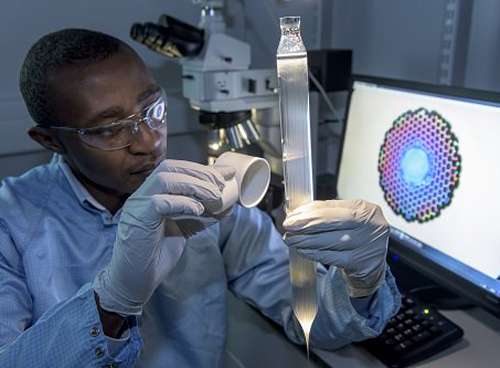Fibre research shows promise for ultra-stable applications

A team from the National Physical Laboratory (NPL) and the University of Southampton has published research into the development of an advanced fibre with zero-sensitivity to temperature changes.
Published in Scientific Reports, the paper, "Ultralow thermal sensitivity of phase and propagation delay in hollow core optical fibres," reveals key developments in optical signal propagation time and frequency characteristics.
The research has been conducted by a team from the Coherent Optical Signals and Microstructured Fibre groups of Southampton's Optoelectronics Research Centre (ORC), in collaboration with the Time & Frequency Group at NPL. It explores the development of a robust hollow core fibre suitable for use in demanding applications, such as the distribution of accurate time signals, that are very sensitive to environmental variation, for example to changes in temperature.
Propagation time through an optical fibre changes with the environmental conditions occurring where the fibre is laid, since changes in the temperature alter both the fibre length (by a tiny but still significant fraction) and the refractive index associated with the silica glass at its core. These changes have a negligible impact for most fibre applications such as telecommunications, however, they can be greatly detrimental in many others such as fibre-based interferometric experiments and devices.
The paper shows that hollow core photonic bandgap fibres have a significantly smaller sensitivity to temperature variations than traditional solid core fibres. The researchers observed a reduction in thermal sensitivity by a factor of 18, making these fibres the most environmentally-insensitive fibre technology available to date.
Dr Giuseppe Marra, of NPL, said: "Optical fibres are playing an increasingly important role in state-of-the-art frequency metrology: from fibre-based devices in the laboratory to the international comparison of optical clocks between National Metrology Institutes. However, in all these ultra-stable applications, the fibre sensitivity to temperature changes is a major concern. The fibre developed at the ORC is opening a whole range of new possibilities."
Dr Radan Slavik, of the University of Southampton, said: "This represents a new and quite exciting research direction for my team. Optical fibre is a great medium for guiding light, but there are still aspects of its performance that are far from ideal with current fibre technology. One of them is its large temperature sensitivity - addressing this issue opens up a whole range of scientifically interesting and industrially relevant applications."
Radan explains: "These fibres are promising candidates for many next-generation fibre system applications that are sensitive to drifts in optical phase or absolute propagation delay. The combination of their unique properties makes the fibres attractive for a range of applications, including gyroscopes, fibre interferometers and the delivery of precise synchronisation signals."
More information: Radan Slavík et al. Ultralow thermal sensitivity of phase and propagation delay in hollow core optical fibres, Scientific Reports (2015). DOI: 10.1038/srep15447
Journal information: Scientific Reports
Provided by National Physical Laboratory


















